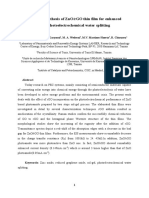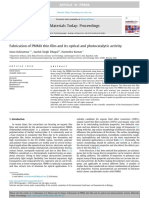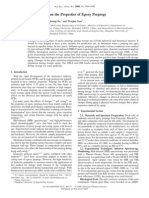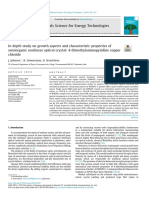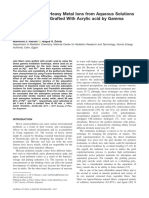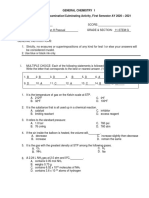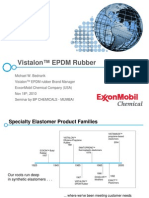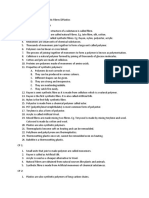Inhibitor 1
Inhibitor 1
Uploaded by
Nisreen MohamedCopyright:
Available Formats
Inhibitor 1
Inhibitor 1
Uploaded by
Nisreen MohamedOriginal Title
Copyright
Available Formats
Share this document
Did you find this document useful?
Is this content inappropriate?
Copyright:
Available Formats
Inhibitor 1
Inhibitor 1
Uploaded by
Nisreen MohamedCopyright:
Available Formats
Open Journal of Polymer Chemistry, 2012, 2, 6-13
http://dx.doi.org/10.4236/ojpchem.2012.21002 Published Online February 2012 (http://www.SciRP.org/journal/ojpchem)
Selectivity of Acrylic Acid Radiation Grafted Non-Woven
Polypropylene Sheets towards Some Heavy Metals Ions
Dalia El-Sayed Hegazy
National Centre for Radiation Research and Technology, Cairo, Egypt
Email: Dalia_eahegazy@ Yahoo.com
Received December 27, 2011; revised January 27, 2012; accepted February 5, 2012
ABSTRACT
Graft polymerization has been considered as a general method for the modification of the physical and chemical proper-
ties of polymeric materials and of particular interest for synthesis of the hydrophilic membrane. In this study, hydro-
philic carboxylic acid groups were introduced by radiation-induced grafting of acrylic acid (AAc) onto non-woven
polypropylene fabric (NWPP). Different irradiation doses and (AAc) monomer concentrations were used to optimize
grafting yield. Characterization and properties of the prepared graft copolymer were studied by employing X-ray Dif-
fraction (XRD), Thermogravimetric Analysis (TGA), Scanning Electron Microscope (SEM ), Fourier Transform Infra-
red Spectrometry (FTIR) and differential scanning calorimeter (DSC). The prepared grafted materials were used for
removing some heavy metals ions. The results showed that the non-woven PP grafted with (AAc) has good affinity to-
ward Cu, Ni and Co.
Keywords: Radiation Grafting; Acrylic Acid; Characterization; Removal of Heavy Metals
1. Introduction base polymer matrix. Moreover, the molecular weight of
the products can be better regulated in radiation tech-
Water contamination with toxic metals causes serious hu-
niques In general; synthesized polymers such as polyeth-
man health problems. Enhanced metal separation tech-
ylene and polypropylene have been used as trunk poly-
niques that require less energy with minimal impact on
mer due to their reactivity in the grafting process and
the environment are desirable. Many kinds of metal ads-
high mechanical strength.
orbents including activated carbon, bentonite and synt-
Non-woven materials have been increasingly used for
hetic polymers have been developed to remove toxic me-
a variety of applications in the world [5]. Non-woven
tals from streaming water [1]. Radiation-induced graft
materials are one of the products popularly used as rein-
polymerization is widely used to produce high perform-
forcements for many applications since they possess a
ance chemically active polymer materials for adsorption
and separation processes on the basis of various com- good combination of strength, lightweight and flexibility
mercial polymers available in different forms (films, fi- compared to conventional materials [6]. Non-woven with
bers, resins, textiles, powders) [2,3].Various approaches specific surface properties are also of interest in many
for synthesizing polymer adsorbents have been devel- technical applications of the materials as the surface fea-
oped, including direct graft polymerization of vinyl mo- tures affect adsorption, abrasion, adhesion, biocompati-
nomers already containing desirable functional groups. bility and other properties of the materials. The advan-
Adsorbents can be easily synthesized by radiation-induced tages of using nonwoven polypropylene NWPP as matrix
graft polymerization. This technique creates an active are their relatively low processing temperature which is
radical in the trunk polymer by means of ionizing radia- essential because of low thermal stability of natural fi-
tion and the polymeric graft chains propagate from the bers and their good properties and lower cost. For these
active radical in the trunk polymer [3,4]. Chemical initia- increasing applications it is desirable to produce such
tion often brings about problems arising from local heat- nonwoven materials with well defined surface properties.
ing of the initiator, an effect that is absent in the forma- Various techniques have been developed to modify the
tion of free-radical sites by radiation, which is only de- surface properties of nonwoven materials [7-9].
pendent upon the absorption of high-energy radiation. In recent years, the removal of hazardous heavy metals
Due to large penetrating power of higher energy radia- from water and soil environments and industrial waste
tion, methods using radiation initiation provide the op- streams has attracted considerable attention. Enhanced
portunity to carry out grafting at different depths of the metal separation techniques that require less energy with
Copyright © 2012 SciRes. OJPChem
D. E.-S. HEGAZY 7
minimal impact on the environment are desirable. amount of transition metal ions are commonly used as
In the present work, radiation grafting of AAc mono- inhibitors (1), ammonium ferrous sulfate (Mohr’s salt)
mer onto non-woven polypropylene fabrics is investi- was added to the reaction medium (0.5 wt%).
gated to obtain homogeneous distributed graft copolymer
chains with high grafting yield. Characterization and pro- 2.4. Fourier-Transform Infrared (FTIR)
perties of the prepared graft copolymer are studied by
To justify the introduction of functional groups onto the
(XRD), (TGA) and (DSC). Also, the study included
nonwoven PP, infrared spectroscopy analysis was carried
measurements of the mechanical properties and determi-
out using a FTIR spectrometer. The infrared spectra of
nation of the tensile strength of these materials as a func-
NWPP and grafted NWPP sheets were performed using
tion of degree of grafting. The application of the pre-
Jasco 6300FT-IR.
pared NWPP-AAc as adsorbent materials for waste water
treatment from heavy and toxic metals is investigated.
2.5. Thermogravimetric Analysis (TGA)
2. Experimental TGA for the investigated samples were performed under
nitrogen atmosphere at a flow rate 50 ml/min. of pure
2.1. Materials
nitrogen gas and the heating rate was 10˚C/min. from
The materials used in this study were needle punched ambient temperature up to 600˚C using Perkin Elmer
nonwovens made of melt blown nonwovens extruded system of type pyris-6 thermal analysis system.
from PP polymers. Film sheets were cut to the dimention
of 4 × 5 cm. The monomer used throughout this work 2.6. DSC Measurements
was acrylic acid (AAc) of laboratory grade chemicals of
Thermal parameters of the prepared grafted NWPP such
purity 99% (Merck).
as; melting temperature (Tm) heat of melting and recrys-
tallization (ΔHm) were determined by differential scan-
2.2. γ-Irradiation
ning calorimeter (DSC) (Perkin Elmer equipped with a
Irradiation to the required doses was carried out using a DSC-7 data station). Specimen (≈5 mg) of the sample is
60
Co γ-cell. The irradiation facility was constructed by used for DSC measurements. Indium and Zinc standards
the National Center for Radiation Research and Tech- were utilized to calibrate the temperature and thermal
nology, Atomic Energy Authority of Egypt. Irradiation scale. The measurements were carried out in N2 atmos-
was carried out in air atmosphere at different irradiation phere at a heating rate of 10˚C min–1.
doses.
2.7. X-ray Diffraction Analysis (XRD)
2.3. Radiation Grafting of Non-Woven
X-ray diffraction (XRD) patterns were recorded using
Polypropylene
Shimadzu X-ray diffractometer (XRD-6000 model) equip-
NWPP sheets were washed with acetone, dried at 50˚C in ped with X-ray tube at operating voltage of 40 kV and an
an electric oven until they attain a constant weight and electric current of 30 mA.
then immersed in the monomer solution in glass tubes.
Distilled water was used as a diluent of AAc. The graft 2.8. Mechanical Properties
copolymers were prepared by direct radiation grafting of
AAc onto NWPP at different irradiation doses. The Tensile tests were performed according to the ASTM
grafted films were removed and washed thoroughly with D412-80 test method and were carried out using an In-
the proper solvent (hot distilled water) in order to extract stron testing machine (Model H10KS from Hounsfield
the residual monomer and homopolymer which may be Co., England, loaded cell 10 KN) at 25˚C and the cross-
accumulated in the film and then soaked overnight in head speed was 10 mm/min. Five samples per formula-
distilled water. These prepared grafted polymers were tion were tested.
then dried in an electric oven at 40˚C for 24 h and
weighed. The degree of grafting was calculated using the 2.9. Metal Uptake Measurement
following equation: The fixed weight of the prepared hydrogel was immersed
Wg W0 in the metal feed solution of definite concentration (100
Degree of grafting % 100 (1) ppm). Merck atomic absorption standard solutions of
W0
these metals were used for the calibration process. The
where W0 and Wg represent the weights of initial and pH and temperature of metal feed solutions were ad-
grafted film, respectively. justed before applying the hydrogels for treatment proc-
To overcome homopolymerization of AAc, a small esses. The remaining metal ions in its feed solution were
Copyright © 2012 SciRes. OJPChem
8 D. E.-S. HEGAZY
determined by an atomic absorption instrument (Unicam 65
Model Solaar 929). 60
The metal uptake (E) was calculated as follows:
Ci C f
Degree of grafting (%)
55
E (mmol/g) (2)
W A 10 50
where W is the weight of the dried grafted film, A is the
45
atomic weight of metal ion and Ci and Cf are the initial
and remaining concentrations of metal ions in mg/l (ppm), 40
respectively. The total uncertainly for all experiments
ranged from 3% - 5%. 35
3. Results and Discussion 0 10 20 30 40 50 60 70
AAc concentration (wt%)
The radiation grafting process of aqueous AAc is usually
Figure 1. Effect of aqueous AAc concentration on the de-
accompanied by undesirable homopolymerization. Metal
gree of grafting onto NWPP at irradiation dose (30 kGy).
salts such as ammonium ferrous sulphate (Mohr’s salt),
suppress homopolymer formation. Fe2+ is well known to 120
have an inhibition effect on free radical graft polymeriza-
tion. However, they can also cause a deactivation of the 100
grafting process and lead to a decrease in grafting degree
Degree of grafting (%)
when taken in excess. In the present study, it was found 80
that the addition of 0.5 wt% of Moher’s salt to the aque-
ous AAc is enough to enhance radiation grafting and 60
minimize the homopolymer formation.
40
3.1. Effect of Monomer Concentration on the
Grafting Yield 20
Among the effective parameters for radiation grafting are 0
the monomer concentration. The effect of AAc monomer 0 10 20 30 40 50
concentration on the grafting yield was investigated as Irradiation dose (kGy)
shown in Figure 1. It is clear that the degree of grafting
Figure 2. Effect of irradiation dose on the degree of grafting
increases by increasing AAc acid to reach a maximum at of AAc (30 wt%).
30 wt% AAc. Thereafter, any increase in monomer con-
centration leads to decrease in the grafting degree. At 30 irradiation dose leads to more free radical formation in
wt% AAc, there is enough monomer available to reach the grafting sites which leads to an increase in the gra-
into the reaction sites on the polymer free radicals, re- fting yield. However, at irradiation doses above 30 kGy,
sulting in higher degrees of grafting. The excess of mo- the content of crosslinked insoluble homopolymer in-
nomer concentration causes suppression of the monomer creased and it was difficult to extract it from the surface
diffusion by increasing the viscosity of the grafting me- of NWPP sheets [11]. Also, a degraded rigid grafted
dium under the homopolymerization effect (the Troms- NWPP sheets was formed at high irradiation dose.
dorff effect) [10].
3.3. Swelling Behavior of the Grafted NWPP in
3.2. Effect of Irradiation Dose Water
Irradiation dose is also an important factor to optimize From the practical point of view, the swelling properties
the grafting process and homogeneity of grafting distri- and its ratio is very important property for its use in
bution. This is due to the initiation of grafting sites and treatment process of waste water and diffusivity of met-
growing chain reactions are very dependent on the amount als through the grafted chains and functional groups. The
of free radicals formed. The effect of irradiation dose on swelling of the prepared NWPP-g-AAc copolymer in
the grafting yield of AAc onto NWPP was investigated water was studied and the results are presented in Figure
and is shown in Figure 2. It is obvious that as the irra- 3. It can be shown that as the degree of grafting increases,
diation dose increases, the grafting degree increases. This the swelling percent increases to reach a maximum at
trend can be explained to the fact that the increase in the degree of grafting around 100%. Thereafter, the swelling
Copyright © 2012 SciRes. OJPChem
D. E.-S. HEGAZY 9
450
400
350
Swelling (%)
300
250
200
150
100
50
40 60 80 100 120 140
Degree of grafting (%)
Figure 3. Swelling percent vs. degree of grafting percent for
NWPP-g-AAc at swelling time (24 h).
percent tends to decrease with further increase in the gr- Figure 4. FTIR spectra for (a) NWPP; (b) NWPP-g-AAc.
afting yield. As the irradiation dose increases, the increase The AAc concentration (30 wt%) and degree of grafting
(64%).
in degree of grafting and cross-linking density which pre-
vents a space for the AAc chain to swell freely in water
and restricts and hindered the diffusivity of water thro-
ugh the cross-linked chains is expected. In other words,
results showed clearly that the increase of irradiation dose
during radiation grafting process enhanced the crosslink-
ing via hydrogen bonding. As a consequence, the water
uptake tends to decrease at high degrees of grafting.
3.4. FTIR Analysis
The FTIR spectra of the original NWPP and grafted
NWPP films were studied and shown in Figure 4. FTIR
spectrum of pure NWPP shows bands appearing at 2840-
2800, 1440 and 1380 cm–1, which are characteristic of the
polypropylene structure. In case of NWPP-g-AAc, a new
Scheme 1. The expected structure of NWPP-g-AAc
peak appears at around 1715.67 cm–1, which can be at-
tributed to the –C = O of PAAc. A characteristic peak 100
around 3500 cm–1 for OH groups of poly acrylic acid is
also appeared. This confirms that acrylic acid containing
90
the carboxyl groups was fixed randomly onto the NWPP
main chains as a grafting side chains [12-14]. Scheme 1
Elongation (%)
shows the expected structure of NWPP-g-AAc. 80
3.5. Mechanical Properties
70
Figures 5 and 6 show changes in percentage elongation
and tensile strength at break for grafted and ungrafted
60
NWPP films, respectively. It can be seen that the elonga-
tion percent at break for the grafted non-woven sheets de-
creases gradually as the grafting degree increases. How- 50
ever, the tensile strength increases with increasing the 40 60 80 100 120 140
degree of grafting up to 66% grafting degree, thereafter, Degree of grafting (%)
any increase in the grafting degree leads to de crease in ten- Figure 5. Elongation percent at break for NWPP-g-AAc
sile strength. The decrease in the percentage elongation having different degrees of grafting.
Copyright © 2012 SciRes. OJPChem
10 D. E.-S. HEGAZY
Table 1. DSC results of NWPP-g-AAc.
Grafting degree (%) Tm ΔHm
0 160 61.9
66 157 14.5
93 155.8 16.6
130 153.8 5.7
shown in Figure 7 and Table 2. The results show that
the thermal stability of NWPP films has been changed by
grafting with AAc. The grafted films exhibited two de-
composition peaks, i.e., the first decomposition occurring
Figure 6. Tensile strength at different degrees of grafting. at around 200˚C - 235˚C may be due to cyclization and
dehydration reactions of -COOH functional groups of the
and the improvement in the tensile strength is expected grafted chains. The decomposition of the second peak
due to the increase of crosslinking sites with increasing should be attributed to the decomposition of the grafted
the number of grafted chains and their lengths [15,16]. film and due to extensive graft chains degradation of the
The cross-linked network structure resulted in a pro- polymer backbone chain.
nounced increase in the tensile strength of grafted sheet It is evident from the thermograms that the ungrafted
in the range from 60%-100% grafting and as consequ- NWPP is thermally stable up to 236˚C.The grafting of
ence the percentage elongation decreased [17,18]. Again, AAc onto NWPP decreases the weight loss of the major
the rigidity of the graft copolymer increases with an in- degradation step compared to that of the ungrafted
crease in degree of grafting due to two reasons; the first NWPP as shown in Table 2. A considerable decrease in
one is the incorporation of the polar groups and their the weight loss of the major degradation step is observed
interactions (the formation of cross-linked network struc- systematically by increasing degree of grafting. The ana-
ture via hydrogen bonding of carboxylic acid groups of lysis of the thermograms shows that the degradation of
PAAc graft chains). The second reason is the formation grafted polymer is controlled mainly by the degree of
of crosslinking network structure, which formed because grafting. In conclusion the introduction of AAc into
of grafting and irradiation, which leads to restriction in NWPP sheets does not affect significantly the thermal
chain mobility [18-20]. The decrease in the tensile stability of the NWPP sheets.
strength of high grafted yield non-woven sheet prepared
at high irradiation dose was due to the degradation of 3.8. X-ray Diffraction Analysis (XRD)
polypropylene non-woven sheet caused at high irradia-
X-ray diffraction of the grafted NWPP was performed
tion dose.
and compared with the base polymer to clarify their
crystallinity morphological structures changes caused by
3.6. DSC Thermal Parameters of Grafted NWPP
the grafting as shown in Figure 8. It is observed that the
In order to determine the effect of grafting degree on the intensity of the diffractogram, representing crystallinity,
thermal parameters of the grafted NWPP, the change in decreases by grafting. This is due to dilution of the crys-
Tm and ΔHm was investigated by DSC technique and is tal line fraction by the incorporation of the amorphous
shown in Table 1. The decrease in Tm and ΔHm values PAAc chains into the polymer matrix. It can be con-
for the grafted NWPP films compared with ungrafted cluded that the graft polymerization took place predomi-
ones can be attributed to the network structure, which nantly on the polymer film surface of the crystallites pro-
had considerable mobility with the molten NWPP. The gressed inward thus breaking up partly ordered chain
results obtained, suggested that the introduction of gra- structures of the NWPP matrix [21].
fted chains into NWPP caused changes in its morpho-
logical structure in which the crystallinity domains in 3.9. Selectivity of NWPP-G-Aac towards
NWPP decreases due to the crosslinking network forma- Different Metals in Mixture
tion that caused by radiation grafting process.
Because of functional groups, which have been introduced
into polymer to be used as chelating polymer, the capacity
3.7. Thermogravimetric Analysis (TGA)
of the polymer is an important factor to determine how
The thermograms for the NWPP and grafted NWPP are much such graft copolymer is required to quantitatively
Copyright © 2012 SciRes. OJPChem
D. E.-S. HEGAZY 11
metals and follows the order Cu > Co > Ni as shown in
Figure 9(a). The results show that the NWPP-g-AAc has
a great ability to adsorb Cu rather than other metals un-
der investigation.
250
200
Capacity(mg/l/gm)
Cu
150
Co
100
Ni
50
Figure 7. Thermogravimetric curves of pure NWPP and the
0
grafted NWPP sheets.
Ni Co Cu
Table 2. TGA data for PP-g-AAc. (a)
250
Grafting Onset Char residue Wt. loss in the major
degree (%) temperature (˚C) (%) degradation step (%)
0 236 2.5 90.5 200
57 225 2.3 89.8
Capacity(mg/l/gm)
Co
66 220 2.1 87
150
93 215 1.5 87
Cu
Co
100
Ni
Ni
Cu
50
50 kGy
Intensity (arbitrary unit)
30 kGy Cu/ Co Cu/ Ni Co/Ni
(b)
20 kGy 160
140
Co
10 kGy
Capacity(mg/l/gm)
120
100
Ni
0 kGy 80
Cu
60
10 20 30 40 50 60 70 80 90 40
2 (deg) 20
Figure 8. XRD patterns for NWPP-AAc graft copolymers 0
prepared by gamma irradiation at different doses. Cu-Co-Ni
(c)
remove a specific metal ion from the solution. Thus, the
Figure 9. (a) The capacity of NWPP-g-AAc towards differ-
capacity of NWPP-g-AAc towards different metals such ent metals; (b) The selectivity of Cu in presence of Ni and
as Cu, Co and Ni was determined and is shown in Figure Co ions; (c) The selectivity of the prepared NWPP-g-AAc in
9. The NWPP-g-AAc has a good affinity towards such a mixture Co, Cu and Ni.
Copyright © 2012 SciRes. OJPChem
12 D. E.-S. HEGAZY
The selectivity of Cu in presence of Ni and Co ions in cations of Ion Exchange Membranes by Radiation-In-
a mixture is investigated using NWPP-g-AAc and the duced Graft Copolymerization of Polar Monomers onto
Non-Polar Films,” Progress in Polymer Science, Vol. 29,
results are shown in Figure 9(b). The selectivity of the
No. 6, 2004, pp. 499-561.
prepared NWPP-g-AAc towards Cu is lower than other doi:10.1016/j.progpolymsci.2004.01.003
metals (Ni and Co). The results show that the -COOH
[4] G. MaKay, “Use of Adsorbents for the Removal of Pol-
groups of AAc have a great ability to adsorb Co rather lutants from Wastewaters,” CRC Press, Boca Raton,
than other metals under investigation including Cu which 1996.
has medium affinity to be adsorbed by the grafted poly- [5] Y.-X. Wang, “Chinese Nonwovens Filter Media Market,”
mer. The affinity of the prepared NWPP-g-AAc towards Filtration & Separation, Vol. 37, No. 10, 2000, pp. 24-25.
Ni is lower than Co. However, the selectivity of the pre- doi:10.1016/S0015-1882(01)80093-8
pared polymer towards Cu in the presence of Ni is lower. [6] G. S. Bhat, “Nonwovens as Three-Dimensional Textiles
Also, the selectivity of the prepared polymer towards Co for Composites,” Material Manufacturing Process, Vol.
in the presence of Cu is higher. 10, No. 4, 1995, pp. 667-688.
The affinity of the prepared NWPP-g-AAc towards Cu, doi:10.1080/10426919508935059
Ni and Co in a mixture was investigated. It is clear that [7] S. H. Choi and Y. C. Nho, “Introduction of Carboxylic
the NWPP-g-AAc prefer Co rather than Ni and Cu. The Acid Group to Polypropylene Fabric for Battery Separa-
selectivity follows the order Co > Ni > Cu. This can be tor,” Korean Journal of Chemical Engineering, Vol. 16,
No. 4, 1999, pp. 505-510. doi:10.1007/BF02698276
shown clearly from the metal uptake by NWPP/AAc
copolymer Figure 9(c). [8] H. J. Park and C. K. Na, “Preparation of Anion Ex-
changer by Amination of Acrylic Acid Grafted Polypro-
The selectivity of the prepared graft copolymer is pylene Nonwoven Fiber and Its Ion-Exchange Property,”
highly dependent on the complex stability formed be- Journal of Colloid and Interface Science, Vol. 301, No. 1,
tween the metal ion and polymer functional groups. The 2006, pp. 46-54. doi:10.1016/j.jcis.2006.05.003
higher the stability of complex the higher the affinity is [9] K. S. Chen, J. C. Tsai, C. W. Chou, M. R. Yang and J. M.
obtained. Among other important factors determining the Yang, “Effects of Additives on the Photo-Induced Graft-
stability and affinity are the metal ion radii, its electronic ing Polymerization of N-Isopropylacrylamide Gel onto
distribution, hydration energy, valency and ionic strength PET Film and PP Nonwoven Fabric Surface,” Materials
[22,23]. Science and Engineering: C, Vol. 20, No. 1-2, 2002, pp.
203-208. doi:10.1016/S0928-4931(02)00034-6
4. Conclusion [10] A. Bozzi and A. Chapiro, “The Nature of the Initiating
Centres for Grafting in Air-Irradiated Perfluoro Poly-
The preparation of grafted nonwoven polypropylene mers,” European Polymer Journal, Vol. 23, No. 3, 1987,
sheets with acrylic acid monomer using ionizing radia- pp. 255-257. doi:10.1016/0014-3057(87)90085-1
tions such as gamma rays from Co-60 was investigated. [11] A. Chapiro, “Radiation Chemistry of Polymeric Sys-
The optimum conditions for this radiation grafting sys- tems,” Interscience, New York, 1962.
tem to obtain suitable grafting yield with homogeneous [12] K. Sato, S. Ikeda, M. Lida, A. Oshima, T. Tabata and M.
distribution were determined. The prepared NWPP-g-AAc Washio, “Study on Poly-Electrolyte Membrane of Cross-
is of a great interest for its applicability in industrial linked PTFE by Radiation-Grafting,” Nuclear Instru-
ments and Methods in Physics Research Section B: Beam
waste treatment from heavy and toxic metals. From the
Interactions with Materials and Atoms, Vol. 208, 2003,
practical point of view, the applicability of the prepared pp. 424-428. doi:10.1016/S0168-583X(03)00898-X
NWPP-g-AAc is very promising due to its high capacity
[13] M. M. Khalil, N. M. EL-Sawy and A. EL-Shobaky,
and selectivity towards different heavy metal ions such “Gamma-Irradiation Effects on the Thermal and Struc-
as Cu, Ni and Co. tural Characteristics of Modified Grafted Polypropylene,”
Journal of Applied Polymer Science, Vol. 102, No. 1,
2006, pp. 506-515. doi:10.1002/app.24236
REFERENCES
[14] B. Cheng, X. Jiao and W. Kang, “Studies on Grafting of
[1] H. Seki and A. Suzuki, “Adsorption of Heavy Metal Ions Acrylic Acid onto Polypropylene Melt-Blown Nonwov-
onto Insolubilized Humic Acid,” Journal of Colloid and ens Induced by Electron-Beam Preirradiation,” Journal of
Interface Science, Vol. 171, No. 2, 1995, pp. 490-494. Applied Polymer Science, Vol. 102, 2006, pp. 4971-4977.
doi:10.1006/jcis.1995.1207 doi:10.1002/app.24841
[2] A. Bhattacharya and B. N. Misra, “Grafting: A Versatile [15] H. M. Said, H. H. Sokker and A. El-Hag Ali, “Acrylation
Means to Modify Polymers: Techniques, Factors and Ap- of Pre-Irradiated Polypropylene and Its Application for
plications,” Progress in Polymer Science, Vol. 29, No. 8, Removal of Organic Pollutants,” Radiation Physics and
2004, pp. 767-814. Chemistry, Vol. 79, No. 4, 2010, pp. 534-539.
doi:10.1016/j.progpolymsci.2004.05.002 doi:10.1016/j.radphyschem.2009.09.005
[3] M. M. Nasef and E. A. Hegazy, “Preparation and Appli- [16] H. Chen, G. R. Palmese and Y. A. Elabd, “Electrosensi-
Copyright © 2012 SciRes. OJPChem
D. E.-S. HEGAZY 13
tive Permeability of Membranes with Oriented Polyelec- Journal of Radiation Applications and Instrumentation.
trolyte Nanodomains,” Macromolecules, Vol. 40, No. 4, Part C. Radiation Physics and Chemistry, Vol. 36, No. 3,
2007, pp. 781-782. doi:10.1021/ma062678q 1990, pp. 365-370. doi:10.1016/1359-0197(90)90020-I
[17] Y. Tang, A. Kusoglu, A. M. Karlsson, M. H. Santare, S. [21] S. Hietala, S. Holmberg, M. Karjalainen, J. Nasman, M.
Cleghorn and W. B. Johnson, “Mechanical Properties of a Paronen, R. Serimaa, F. Sundholm and S. Vahvaselka,
Reinforced Composite Polymer Electrolyte Membrane “Structural Investigation of Radiation Grafted and Sul-
and Its Simulated Performance in PEM Foil Cells,” Jour- fonated Poly(Vinylidene Fluoride), PVDF, Membranes,”
nal of Power Sources, Vol. 175, No. 2, 2008, pp. 817-825. Journal of Materials Chemistry, Vol. 7, No. 5, 1997, pp.
doi:10.1016/j.jpowsour.2007.09.093 721-726. doi:10.1039/a607675k
[18] E. A. Hegazy, H. Kamal, N. A. Khalifa and Gh. A. Mah- [22] I. E. A. Hegazy, H. A. Abd El-Rehim and H. A. Shawky,
moud, “Ion Exchange Membranes for Metal Ions Separa- “Investigation and Characterization of Radiation Grafted
tion,” Iranian Polymer Journal, Vol. 8, No. 4, 1999, pp. Copolymers for Possible Practical Use in Waste Water
223-230. Treatment,” Radiation Physics and Chemistry, Vol. 57,
[19] M. F. Abou Taleb, Gh. A. Mahmoud, S. M. Elsigeny and No. 1, 2000, pp. 85-95.
E. A. Hegazy, “Adsorption and Desorption of Phosphate doi:10.1016/S0969-806X(99)00312-6
and Nitrate Ions Using Quaternary (Polypropylene-g-N, [23] H. A. Abd El-Rehim, E. A. Hegazy and A. El-Hag Ali
N-Dimethylamino Ethylmethacrylate) Graft Copolymer,” “Selective Removal of Some Heavy Metal Ions from
Journal of Hazardous Materials, Vol. 159, No. 2-3, 2008, Aqueous Solution Using Treated Polyethylene-g-Styrene/
pp. 372-379. doi:10.1016/j.jhazmat.2008.02.028 Maleic Anhydride Membranes,” Reactive & Functional
[20] E. A. Hegazy, S. M. Mokhtar, M. B. S. Osman and A. B. Polymers, Vol. 43, No. 1-2, 2000, pp. 105-116.
Mostafa, “Study on Non-Ionic Membrane Prepared by doi:10.1016/S1381-5148(99)00009-7
Radiation-Induced Graft Polymerization,” International
Copyright © 2012 SciRes. OJPChem
You might also like
- Idoc - Pub - Gilded Reverie Lenormand Exp Ed Extra Cards - Pt.enDocument14 pagesIdoc - Pub - Gilded Reverie Lenormand Exp Ed Extra Cards - Pt.enNisreen Mohamed100% (1)
- Ancestral Path Tarot LWBDocument18 pagesAncestral Path Tarot LWBNisreen MohamedNo ratings yet
- Binders in Textile PrintingDocument4 pagesBinders in Textile PrintingAkshay Bhagat100% (2)
- One Pot Synthesis, Characterization of ZN GO Nanocomposite For The Electrochemical Decoloration of A Textile DyeDocument7 pagesOne Pot Synthesis, Characterization of ZN GO Nanocomposite For The Electrochemical Decoloration of A Textile DyeEditor IJTSRDNo ratings yet
- PANI-doped BenzeneDocument9 pagesPANI-doped BenzeneChris SmithNo ratings yet
- 1 s2.0 S0144861717303223 Main PDFDocument9 pages1 s2.0 S0144861717303223 Main PDFRashmi RahagudeNo ratings yet
- Fabrication of Nitrogen-Doped Porous Electrically Conductive Carbon Aerogel From Waste Cabbage For Supercapacitors and Oil Water SeparationDocument11 pagesFabrication of Nitrogen-Doped Porous Electrically Conductive Carbon Aerogel From Waste Cabbage For Supercapacitors and Oil Water SeparationAnh DuyNo ratings yet
- Sol-Gel Synthesis of Zno/Rgo Thin Film For Enhanced Photoelectrochemical Water SplittingDocument18 pagesSol-Gel Synthesis of Zno/Rgo Thin Film For Enhanced Photoelectrochemical Water SplittingchtououNo ratings yet
- Impact - Modified - Epoxymontmorillonite - NanocompositeDocument8 pagesImpact - Modified - Epoxymontmorillonite - NanocompositeVansala GanesanNo ratings yet
- Synthesis, Structural and Magnetic Properties of Copper Substituted Nickel PDFDocument6 pagesSynthesis, Structural and Magnetic Properties of Copper Substituted Nickel PDFjeyaraman anandharajNo ratings yet
- Polymer: Adil Sultan, Faiz MohammadDocument12 pagesPolymer: Adil Sultan, Faiz MohammadenggsantuNo ratings yet
- Antibacterial and Photocatalytic Properties of Ag/Tio /zno Nano - Owers Prepared by Facile One-Pot Hydrothermal ProcessDocument8 pagesAntibacterial and Photocatalytic Properties of Ag/Tio /zno Nano - Owers Prepared by Facile One-Pot Hydrothermal ProcessDaniel ReyesNo ratings yet
- Chandramika BoraDocument7 pagesChandramika BoraMahalingam SNo ratings yet
- Torkashvand 2019Document9 pagesTorkashvand 2019ngochuongdungNo ratings yet
- Adsorptive Removal of Crystal Violet (CV), A Carcinogenic Textile Dye, From Aqueous Solution by Conducting Polyaniline/ Hollow Manganese Ferrite NanocompositesDocument9 pagesAdsorptive Removal of Crystal Violet (CV), A Carcinogenic Textile Dye, From Aqueous Solution by Conducting Polyaniline/ Hollow Manganese Ferrite NanocompositesIolanda VeronicaNo ratings yet
- Experimental Study of Mechanical and Electrical Properties of CarbonDocument8 pagesExperimental Study of Mechanical and Electrical Properties of CarbonSufian HijazNo ratings yet
- Fabrication of PMMA Thin Film and Its Optical and P - 2022 - Materials Today PRDocument5 pagesFabrication of PMMA Thin Film and Its Optical and P - 2022 - Materials Today PRRauta Robert StefanNo ratings yet
- Effects of Storage Aging On The Properties of Epoxy PrepregsDocument6 pagesEffects of Storage Aging On The Properties of Epoxy PrepregsgnanasekarNo ratings yet
- Analisis Spektrum PolianilinDocument7 pagesAnalisis Spektrum PolianilinSiti Nur Aliza FauziahNo ratings yet
- p3Document12 pagesp3Shaista TaimurNo ratings yet
- Synthesis and Characterization of Some Modified Natural Nanocomposite Polymers and Study Their Thermal and Mechanical PropertiesDocument12 pagesSynthesis and Characterization of Some Modified Natural Nanocomposite Polymers and Study Their Thermal and Mechanical PropertiesIJAR JOURNALNo ratings yet
- Structural Characterization, Electrical Properties and Gas Sensing Applications of polypyrrole/Cu-Al O Hybrid NanocompositesDocument10 pagesStructural Characterization, Electrical Properties and Gas Sensing Applications of polypyrrole/Cu-Al O Hybrid Nanocompositesriaz hosen shohagNo ratings yet
- BF03353695Document5 pagesBF03353695Murad HossenNo ratings yet
- ChemreschDocument6 pagesChemreschshrihanmisra0710No ratings yet
- Iron/multiwalled Carbon Nanotube (Fe/MWCNT) Hybrid Materials Characterization: Thermogravimetric Analysis As A Powerful Characterization TechniqueDocument9 pagesIron/multiwalled Carbon Nanotube (Fe/MWCNT) Hybrid Materials Characterization: Thermogravimetric Analysis As A Powerful Characterization TechniqueSajid HussainNo ratings yet
- Nanomaterials 08 01069Document21 pagesNanomaterials 08 01069ANSHIDA ROUNA A N IMS21031No ratings yet
- 1 s20 S2352152X24036570 Main - 241021 - 143004Document12 pages1 s20 S2352152X24036570 Main - 241021 - 143004Javid AmirNo ratings yet
- Enhanced Photocatalytic Performance of ZnO Loaded Cotton Stalk Activated Carbon Composite On MB and RHB Dyes Under Sunlight IrradiationDocument10 pagesEnhanced Photocatalytic Performance of ZnO Loaded Cotton Stalk Activated Carbon Composite On MB and RHB Dyes Under Sunlight IrradiationIJRASETPublicationsNo ratings yet
- Essay 01Document10 pagesEssay 01maedeh.216.froNo ratings yet
- A Review of Silver Nanoparticles: Synthesis Methods, Properties and ApplicationsDocument8 pagesA Review of Silver Nanoparticles: Synthesis Methods, Properties and ApplicationsNaveenNo ratings yet
- 1024 3538 1 PBDocument5 pages1024 3538 1 PBkevindomz54No ratings yet
- One-Pot Synthesis of Graphene-Molybdenum Oxide Hybrids and Their Application To Supercapacitor ElectrodesDocument6 pagesOne-Pot Synthesis of Graphene-Molybdenum Oxide Hybrids and Their Application To Supercapacitor ElectrodeskandasamyNo ratings yet
- In Depth Study On Growth Aspects and Characteristic Properties of Semiorganic Nonlinear Optical Crystal 4-Dimethylaminopyridine Copper ChlorideDocument8 pagesIn Depth Study On Growth Aspects and Characteristic Properties of Semiorganic Nonlinear Optical Crystal 4-Dimethylaminopyridine Copper ChlorideOnime No IchinoseNo ratings yet
- Shadpour Mallakpour and Atefeh JarahiyanDocument18 pagesShadpour Mallakpour and Atefeh JarahiyanstudyNo ratings yet
- 2021 ArticleDocument17 pages2021 ArticleKUMAR RAJASEKARNo ratings yet
- 1 s2.0 S2667010021001724 MainDocument20 pages1 s2.0 S2667010021001724 MainAly MohamedNo ratings yet
- Self-Assembled Palladium Nanoparticles On Carbon NanofibersDocument6 pagesSelf-Assembled Palladium Nanoparticles On Carbon NanofiberswwNo ratings yet
- High T, Ambipolar, and Near-Infrared Electrochromic Anthraquinone-Based Aramids With Intervalence Charge-Transfer BehaviorDocument9 pagesHigh T, Ambipolar, and Near-Infrared Electrochromic Anthraquinone-Based Aramids With Intervalence Charge-Transfer BehaviorManthan JainNo ratings yet
- J N S C: Green Synthesis of Zirconia (Zro) Nanoparticles Using Curcuma Resin (Ep) /zro NanocompositesDocument6 pagesJ N S C: Green Synthesis of Zirconia (Zro) Nanoparticles Using Curcuma Resin (Ep) /zro NanocompositesHASNA NOVIANTINo ratings yet
- Vidhu2015 - Sno2 AntibacteriaDocument8 pagesVidhu2015 - Sno2 AntibacteriaBagavananth RajNo ratings yet
- Synthesis and Studies of PANI/Cerium Dioxide Nanocomposites: E. Kumar, P. SelvarajanDocument4 pagesSynthesis and Studies of PANI/Cerium Dioxide Nanocomposites: E. Kumar, P. SelvarajansobisobiNo ratings yet
- Compositional Engineering of Acceptors FDocument8 pagesCompositional Engineering of Acceptors FkardesimnaberyaNo ratings yet
- Suresh 2014Document12 pagesSuresh 2014Pranav PrajapatiNo ratings yet
- Dolomite InorgMater Engl 2011Document7 pagesDolomite InorgMater Engl 2011Faissal El KhazantiNo ratings yet
- ZnO BiosintezaDocument4 pagesZnO BiosintezaClaudia UngureanuNo ratings yet
- Facile Chemical Synthesis of Mg-Doped NiMnO3 Perovskite Based Nano-Structured Materials: Application in Photocatalysis and SupercapacitorsDocument14 pagesFacile Chemical Synthesis of Mg-Doped NiMnO3 Perovskite Based Nano-Structured Materials: Application in Photocatalysis and Supercapacitorskainat shahzadiNo ratings yet
- Ppap 201300152Document13 pagesPpap 201300152Rose Bonilla PeregrinoNo ratings yet
- Physico-Mechanical Properties Changes in Virgin and Recycled Polyethylene Fibers During Recycling ProcessDocument6 pagesPhysico-Mechanical Properties Changes in Virgin and Recycled Polyethylene Fibers During Recycling ProcessBenhazen Lynn DeirdreNo ratings yet
- A One Step Facile Route Synthesis of Copper Oxide Reduced Graphene Oxide Nanocomposite For Supercapacitor ApplicationsDocument13 pagesA One Step Facile Route Synthesis of Copper Oxide Reduced Graphene Oxide Nanocomposite For Supercapacitor ApplicationsSanju TanwarNo ratings yet
- Synthesis and Characterization of Magnesium Borate Via Sol Gel Method and Electrospinning MethodDocument6 pagesSynthesis and Characterization of Magnesium Borate Via Sol Gel Method and Electrospinning MethodEditor IJTSRDNo ratings yet
- 1 s2.0 S0266353816300185 MainDocument9 pages1 s2.0 S0266353816300185 MainmechanicalsrivasansNo ratings yet
- Sivakumar 2015Document27 pagesSivakumar 2015Berga PlaysNo ratings yet
- Chapter 8 ConclusionDocument4 pagesChapter 8 ConclusionMr. M. VENKATESHNo ratings yet
- Nitrogen Embedded Small Molecule Semiconducting Materials Effec 2019 Dyes ADocument8 pagesNitrogen Embedded Small Molecule Semiconducting Materials Effec 2019 Dyes Aمحمد ريزقيNo ratings yet
- 1 s2.0 S0254058418310757 MainDocument7 pages1 s2.0 S0254058418310757 Mainwb9269xkzkNo ratings yet
- Cena2016 Impéance ConductivitéDocument9 pagesCena2016 Impéance ConductivitéمحمدNo ratings yet
- Green Synthesis of Zinc Oxide Nanoparticles A ComparisonDocument7 pagesGreen Synthesis of Zinc Oxide Nanoparticles A ComparisonHazel Rene Gallegos MorenoNo ratings yet
- An Electrochemical Daunorubicin SensorDocument8 pagesAn Electrochemical Daunorubicin Sensorpuja dasNo ratings yet
- Synthesis of Iron Oxide Nanoparticles of Narrow Size Distribution On Polysaccharide TemplatesDocument4 pagesSynthesis of Iron Oxide Nanoparticles of Narrow Size Distribution On Polysaccharide TemplatesdarunthirunaNo ratings yet
- One-Pot Synthesis of Multifunctional Graphitic Carbon-Metal OxideDocument12 pagesOne-Pot Synthesis of Multifunctional Graphitic Carbon-Metal OxideMihaiNo ratings yet
- Surfactant Effect On Synthesis and Electrochemical Properties of Nickel-Doped Magnesium Oxide (Ni-Mgo) For Supercapacitor ApplicationsDocument9 pagesSurfactant Effect On Synthesis and Electrochemical Properties of Nickel-Doped Magnesium Oxide (Ni-Mgo) For Supercapacitor ApplicationsDEPT EEENo ratings yet
- Nanomaterials: An Approach Towards Environmental RemediationFrom EverandNanomaterials: An Approach Towards Environmental RemediationNo ratings yet
- A Comparative Study of Mechanical Properties of Zinc Acrylate Epoxy nanocomposites Reinforced by AL2O3 and Cloisite®30B and Their Mixture: Tensile Strength and Fracture Toughness: A Comparative Study of Mechanical Properties of Zinc Acrylate Epoxy nanocomposites Reinforced by AL2O3 and Cloisite®30B and Their Mixture: Tensile Strength and Fracture ToughnessFrom EverandA Comparative Study of Mechanical Properties of Zinc Acrylate Epoxy nanocomposites Reinforced by AL2O3 and Cloisite®30B and Their Mixture: Tensile Strength and Fracture Toughness: A Comparative Study of Mechanical Properties of Zinc Acrylate Epoxy nanocomposites Reinforced by AL2O3 and Cloisite®30B and Their Mixture: Tensile Strength and Fracture ToughnessNo ratings yet
- Deviant Moon Tarot Patrick ValenzaDocument339 pagesDeviant Moon Tarot Patrick ValenzaNisreen MohamedNo ratings yet
- Moussa 2017Document10 pagesMoussa 2017Nisreen MohamedNo ratings yet
- Study The Influence of Sro Substitution For Cao and Gamma Irradiation On The Properties of 45S5 BioglassDocument12 pagesStudy The Influence of Sro Substitution For Cao and Gamma Irradiation On The Properties of 45S5 BioglassNisreen MohamedNo ratings yet
- Zhang 2017Document46 pagesZhang 2017Nisreen MohamedNo ratings yet
- Lenormand Combination CardsDocument30 pagesLenormand Combination CardsNisreen MohamedNo ratings yet
- FT-IR InterfaceDocument8 pagesFT-IR InterfaceNisreen MohamedNo ratings yet
- System AppendPDF Proof HiDocument31 pagesSystem AppendPDF Proof HiNisreen MohamedNo ratings yet
- Nanocomposite Foam of PolyanilineDocument6 pagesNanocomposite Foam of PolyanilineNisreen MohamedNo ratings yet
- Inhibitor 3Document7 pagesInhibitor 3Nisreen MohamedNo ratings yet
- tm130 Soil ResistanceDocument19 pagestm130 Soil ResistanceNisreen MohamedNo ratings yet
- Article 3Document28 pagesArticle 3Nisreen MohamedNo ratings yet
- Vinyl Additive Technology - 2022 - Issue InformationDocument5 pagesVinyl Additive Technology - 2022 - Issue InformationNisreen MohamedNo ratings yet
- The Physico Mechanical Properties of Gamma IrradiaDocument14 pagesThe Physico Mechanical Properties of Gamma IrradiaNisreen MohamedNo ratings yet
- صباغه متنوعDocument22 pagesصباغه متنوعNisreen MohamedNo ratings yet
- Felix Fontaine's Dice-Throw Meanings (3-Dice) : (Circa 1862)Document4 pagesFelix Fontaine's Dice-Throw Meanings (3-Dice) : (Circa 1862)Nisreen MohamedNo ratings yet
- Graft Copolymerized Chitosan-Present Status and ApplicationsDocument17 pagesGraft Copolymerized Chitosan-Present Status and ApplicationsNisreen MohamedNo ratings yet
- Mechanical Properties of Solid Polymers: Constitutive Modelling of Long and Short Term BehaviourDocument155 pagesMechanical Properties of Solid Polymers: Constitutive Modelling of Long and Short Term BehaviourNisreen MohamedNo ratings yet
- Back To The Origin: A Spick-And-Span Sustainable Approach For The Devulcanization of Ground Tire RubberDocument19 pagesBack To The Origin: A Spick-And-Span Sustainable Approach For The Devulcanization of Ground Tire RubberNisreen MohamedNo ratings yet
- Nuclear: Study of Paramagnetic Species in γ-irradiated Lithium Borate Glasses Doped With Cu IonsDocument13 pagesNuclear: Study of Paramagnetic Species in γ-irradiated Lithium Borate Glasses Doped With Cu IonsNisreen MohamedNo ratings yet
- Asa1 PG0Document22 pagesAsa1 PG0Nisreen MohamedNo ratings yet
- Fulltext 5Document10 pagesFulltext 5Nisreen MohamedNo ratings yet
- VNL 21603Document8 pagesVNL 21603Nisreen MohamedNo ratings yet
- Optical Study of Gamma Irradiated Sodium Metaphosphate Glasses Containing Divalent Metal Oxide Mo (Zno or Cdo)Document11 pagesOptical Study of Gamma Irradiated Sodium Metaphosphate Glasses Containing Divalent Metal Oxide Mo (Zno or Cdo)Nisreen MohamedNo ratings yet
- Wound HealingDocument7 pagesWound HealingNisreen MohamedNo ratings yet
- Impact of Nanotechnology On Biomedical Sciences Review of Current Concepts On Convergence of NanoteDocument14 pagesImpact of Nanotechnology On Biomedical Sciences Review of Current Concepts On Convergence of NanoteNisreen MohamedNo ratings yet
- 6 PDFDocument11 pages6 PDFNisreen MohamedNo ratings yet
- Dear AuthorDocument15 pagesDear AuthorNisreen MohamedNo ratings yet
- Preparation and Characterization of Immobilizing Radioactive Waste Glass From Industrial WastesDocument14 pagesPreparation and Characterization of Immobilizing Radioactive Waste Glass From Industrial WastesNisreen MohamedNo ratings yet
- Assignment 05: Identify The Product (Repeating Units) of Following Reactions (28 Marks)Document8 pagesAssignment 05: Identify The Product (Repeating Units) of Following Reactions (28 Marks)Anonymous Zsi5ODm2PYNo ratings yet
- Fundamental Principles of EmulsionDocument17 pagesFundamental Principles of EmulsionClitor Fernandes de SouzaNo ratings yet
- Strictly, No Erasures or Superimpositions of Any Kind For Test I or Else Your Answers Will Be Considered InvalidDocument7 pagesStrictly, No Erasures or Superimpositions of Any Kind For Test I or Else Your Answers Will Be Considered InvalidEli HarrisNo ratings yet
- Unit 3 PDFDocument80 pagesUnit 3 PDFRut JoshiNo ratings yet
- Brochure Carbon Additives For PolymersDocument24 pagesBrochure Carbon Additives For PolymersTUNG100% (1)
- SDP Technical ManualDocument137 pagesSDP Technical ManualPavan KashappagoudarNo ratings yet
- Title of MagazineDocument55 pagesTitle of MagazineJAMILAH JAVIER ORTIZNo ratings yet
- Pre Program Assignment 2022-23Document38 pagesPre Program Assignment 2022-23keshav654mehtaNo ratings yet
- Fine Chemicals For Cosmetic and Pharmaceutical ApplicationsDocument1 pageFine Chemicals For Cosmetic and Pharmaceutical Applicationscontentdrive4 drive4No ratings yet
- Vistalon Bimodal Rubber - Nov 18th 2010Document24 pagesVistalon Bimodal Rubber - Nov 18th 2010Aryan ShahNo ratings yet
- 1979 - Polymer Alloys IIDocument284 pages1979 - Polymer Alloys IIRiot DangerNo ratings yet
- Protein Analysis in Food Assessing Nutritional Value and QualityDocument16 pagesProtein Analysis in Food Assessing Nutritional Value and QualityPshtiwan SaidNo ratings yet
- Chapter 1Document29 pagesChapter 1Tito LacbayenNo ratings yet
- 1 s2.0 S2452199X22004303 MainDocument20 pages1 s2.0 S2452199X22004303 MainJorge MoleroNo ratings yet
- Aroon v. Shenoy (Auth.) - Rheology of Filled Polymer Systems-Springer Netherlands (1999)Document483 pagesAroon v. Shenoy (Auth.) - Rheology of Filled Polymer Systems-Springer Netherlands (1999)Swetha100% (2)
- Stress Enhancement in The Delayed Yielding of Colloidal GelsDocument4 pagesStress Enhancement in The Delayed Yielding of Colloidal GelsFionaRoyNo ratings yet
- Class Viii Science Chap 3 Synth FibresDocument4 pagesClass Viii Science Chap 3 Synth FibresAbhaygyan SinghNo ratings yet
- Measurement and Prediction of The Surface Temperature in Polymer Gears and Its Relationship To Gear WearDocument6 pagesMeasurement and Prediction of The Surface Temperature in Polymer Gears and Its Relationship To Gear WearAHMED WALIDNo ratings yet
- Plastics: Why Is Widely Used? Definition of TermsDocument9 pagesPlastics: Why Is Widely Used? Definition of TermsrenaNo ratings yet
- CFR 2013 Title21 Vol3 Sec176 170Document28 pagesCFR 2013 Title21 Vol3 Sec176 170Joel CortésNo ratings yet
- Berkland, JCR 2001Document16 pagesBerkland, JCR 2001Dan PackNo ratings yet
- Part II - PG - Programmes - 2016-18 PDFDocument174 pagesPart II - PG - Programmes - 2016-18 PDFkkonthenetNo ratings yet
- PDF ChemDocument52 pagesPDF Chempallavishirsath2003No ratings yet
- c4 PolymerDocument9 pagesc4 PolymerTeoh YuanxinNo ratings yet
- Food BiotechnologyDocument13 pagesFood BiotechnologyadhyNo ratings yet
- Groupe 3 - Blanchet - Belfar - Humeau - Protocole Semestre 6Document13 pagesGroupe 3 - Blanchet - Belfar - Humeau - Protocole Semestre 6cloclohumoNo ratings yet
- Experimental Data and Theoretical ConsidDocument21 pagesExperimental Data and Theoretical Considmarco_ravelo_10No ratings yet
- Jurnal Polimer Fix PDFDocument5 pagesJurnal Polimer Fix PDFSherly Marcia DevanaNo ratings yet
- Equipment For CompoudersDocument13 pagesEquipment For CompoudersNguyen Xuan GiangNo ratings yet







